








By Suzan Filipek
Nine appeals were filed last month against a City of Los Angeles decision approving portions of a proposed expansion and modernization plan for the former CBS Television City at Beverly Boulevard and Fairfax Avenue.
The 1.9 million square-foot TVC 2050 Project is too big, too tall and too dense, according to one appellant, the Miracle Mile Residential Association (MMRA).
In its “reason for appeal” letter, the MMRA incorporated comments from appellants The Grove LLC, A.F. Gilmore, Save Beverly Fairfax, Mayer Beverly Park LP, Beverly Wilshire Homes Association and Neighbors for Responsible TVC Development.
The remaining two appellants are Fix the City and Park La Brea Impacted Residents Group.
The appeals concern determinations by the Los Angeles Dept. of City Planning Deputy Advisory Agency approving a vesting tract map and an environmental impact report.
“The residential neighborhoods surrounding TVC are unsuitable for a project with the density of a studio PLUS office park,” Neighbors for Responsible TVC Development wrote. “An office park compo-

nent in addition to an updated, modern, and efficient operational studio is just too much.”
Sept. 12 hearing
The appeals are slated to be heard before the City Planning Commission on Thurs., Sept. 12. The appeals were filed by a June 7 deadline following the first public hearing on the project on May 15.
That virtual hearing was led by city planners More Song and Paul Caporaso.
A record 185 people spoke at the May 15 hearing, where several homeowner groups and residents said they welcomed a state-of-the art television and film studio at the site, but not of the mega-scale of the
project as proposed.
“We have never opposed a studio. This project is an office park masquerading as a studio expansion,” said Danielle Peters, co-chair of Neighbors for Responsible TVC Development.
Project supporters Representatives of labor unions, state and city film and television associations and numerous area residents spoke in favor of the project on May 15.
Karla Sayles, deputy director of the California Film Commission, said this project would drive economic growth and was a necessity as “the competition from other states and countries is fierce.”
Brian Glodney, executive vice president for development and planning at project developer Hackman Capital Partners, spoke of CBS’ 1952 opening and of the facility being the home of “The Tonight Show starring Johnny Carson,” “The Jeffersons,” and “The Price is Right,” among other iconic shows.
TVC will continue to evolve and adapt the studio facility with good-paying jobs and will revitalize the area, Glodney said. “Our position as the entertainment capital of the world can’t last if we don’t invest in the future. Productions are leaving, we have an aging supply, and we lack
modern facilities.”
Supporters heralded the all-electric studio design of Foster + Partners, Adamson Associates Inc. and RIOS, as well as the project’s proposed Mobility Hub to connect employees to nearby transit including the Metro D (Purple) Line’s nearly complete Wilshire / Fairfax station.
The developer-proposed TVC 2050 Specific Plan would permit a total of 1,874,000 square feet on the 25-acre property. If approved, the $1.25-billion project will consist of sound stage, production support, production office, general office, and retail uses. It retains the historic Television City red façade facing Beverly.
Several speakers supported the developer’s recent density reduction — of 150,000 square feet of the general office space — by removing a 15-story west tower, which was done after City Councilwoman Katy Yaroslavsky, 5th District, requested the developer respond to neighborhood concerns about the overall size and scope of the project. Still too large
It’s still the size of “two Staples Centers right dab in the middle of a residential district,” Peters, of Neighbors for Responsible TVC Develop-

William Murtagh, first “keeper” of the National Register of Historic Places, once remarked, “It has been said that, at its best, preservation engages the past in a conversation with the present over a mutual concern for the future.” In Los Angeles today, preservation has found itself engaging the past and the present in a conversation over housing, the number one sociopolitical land-use issue over which the powers that be in our city struggle. While this conversation has become
(Continued from Page 2)
ment, said at the hearing.
The project’s 550,000 square feet of general office space was a major sticking point for many.
“The 550,000 square feet of general office space can be used for anything [such as real estate and insurance offices]. There is a sensible compromise, to build [just] the actual studio. It’s a winwin,” said Peters.
Opponents called the Environmental Impact Report inadequate in studying noise, traffic and other issues that will affect the neighborhood for years to come.
Several speakers asked the Planning Dept. to review the
strained as of late because developer-backed “housing advocates” have eyed anything that smacks of delay or qualification on residential development as an enemy, our city planners have helpfully pulled an old and trusted instrument from the toolbox — the Adaptive Reuse Ordinance, which has repeatedly proven that past and present can see eye to eye.
hearing
The Los Angeles City Planning Department held its first public hearing June 27 on its
project further before giving the developer the go-ahead.
Michelle Black, of the Beverly Wilshire Homes Association, said the project is giving the developer a “20-year blank check… the plans are conceptual… the EIR fails to disclose traffic and safety and fails to study cut-through traffic.”
The developer’s request for a 20-year phased-in construction project was a frequently-cited point of concern.
“The elephant in the room is that the Wilshire Community Plan is out of date,” said attorney Allan Abshez, representing the A.F. Gilmore Co., which owns The Original Farmers Market next door.
“This project is being rushed.”
Other concerns include a proposed Sign District with
Brian Curran

proposed Citywide Adaptive Reuse Ordinance, which is one of the key strategies of the department’s Citywide Housing Incentive Program (CHIP). Los Angeles’ first Adaptive Reuse Ordinance, adopted in 1999, led to the
digital signage whose impacts on the surrounding neighborhoods are unclear.
Traffic
Dale Kendall of Save Beverly Fairfax echoed others’ concerns re traffic: “It will be a huge disruption to our residential neighborhood and [the traffic] will bring the community to a complete standstill.”
Some speakers remember working at CBS years ago, such as Randy West. He recalled that he and the crew of “The Price is Right” would often meet at offices on Sunset or Wilshire boulevards, and then drive back and forth to the Beverly and Fairfax studio, because CBS lacked offices.
Miracle Mile resident Alex Stemkovsky said to those who complained about the con-
construction of more than 12,000 housing units in historic structures in Downtown Los Angeles, including in such iconic buildings as the turquoise-tiled Art Deco Eastern Columbia Building. Targeted Adaptive Reuse Ordinances also were applied to Community Redevelopment Areas such as Hollywood, Wilshire Center / Koreatown, Central Avenue, Chinatown and Lincoln Heights. These policies repeatedly produced successful results in terms of new housing and the pres-
struction that it’s on a par with the disruption caused by the subway, LACMA and other projects in the area. “It’s life in the big city. You’re never going to please everyone… legitimate concerns should be addressed and fixed. This is a much, much needed improvement to the city and will improve the lives of thousands of people in the city.”
Several residents were impressed with Hackman’s community outreach the past five years, including offering tours and building a children’s playground at Pan Pacific Park after the previous playground was destroyed in an arson fire. Safety was mentioned on both sides. Some welcomed the walkability they thought the project would bring.
ervation of architectural treasures.
As the new citywide ordinance rolls out for review, it provides numerous and updated incentives to promote reuse. Buildings now only have to be 15 years old to qualify for residential conversion and an expedited process for approvals. These existing structures will also receive more accommodating building standards, and those deemed an historic resource can also take advantage of the California Historic
(Please turn to Page 7)
Others raised safety concerns from added traffic. What’s next?
Planning staff will submit a report to the Los Angeles City Planning Commission prior to the Sept. 12 hearing.
Copies of the report will be made available at planning. lacity.gov prior to the hearing. Written public comments can still be submitted to paul.caporaso@lacity.org. Write “TVC 2050” in the subject line.
The Planning Commission will also take public comments in September, to be followed by forwarding its recommendation to the Council’s Planning and Land Use Management (PLUM) Committee for consideration, followed by review and possible action by the full City Council.

By Suzan Filipek
The City Planning Dept. gave the go-ahead to the owner / developer of a controversial six-story building last month, pending compliance with conditions that include a maximum 64 total units with 51 of those for low-income households.
The project, at 800 Lorraine Boulevard, is located in the Windsor Village Historic Preservation Overlay Zone (HPOZ). Its height and density would have been prohibited prior to the mayor’s Executive Directive 1 (ED1), which speeds construction of 100-percent affordable housing to address the city’s homelessness crisis.
Developer / owner Nima Montazeri received a June 14 Letter of Compliance to construct the project on what is now a vacant, formerly single-family, corner lot.
“Public hearings are not required for ED 1 projects. The Letter of Compliance for this project has been issued, and it does not have an appeal period,” a Planning Dept. spokesperson said in an email to the Chronicle Architect and nearby resident, John Kaliski, FAIA, said of the approval of the Lorraine project: “I am very disappoint-
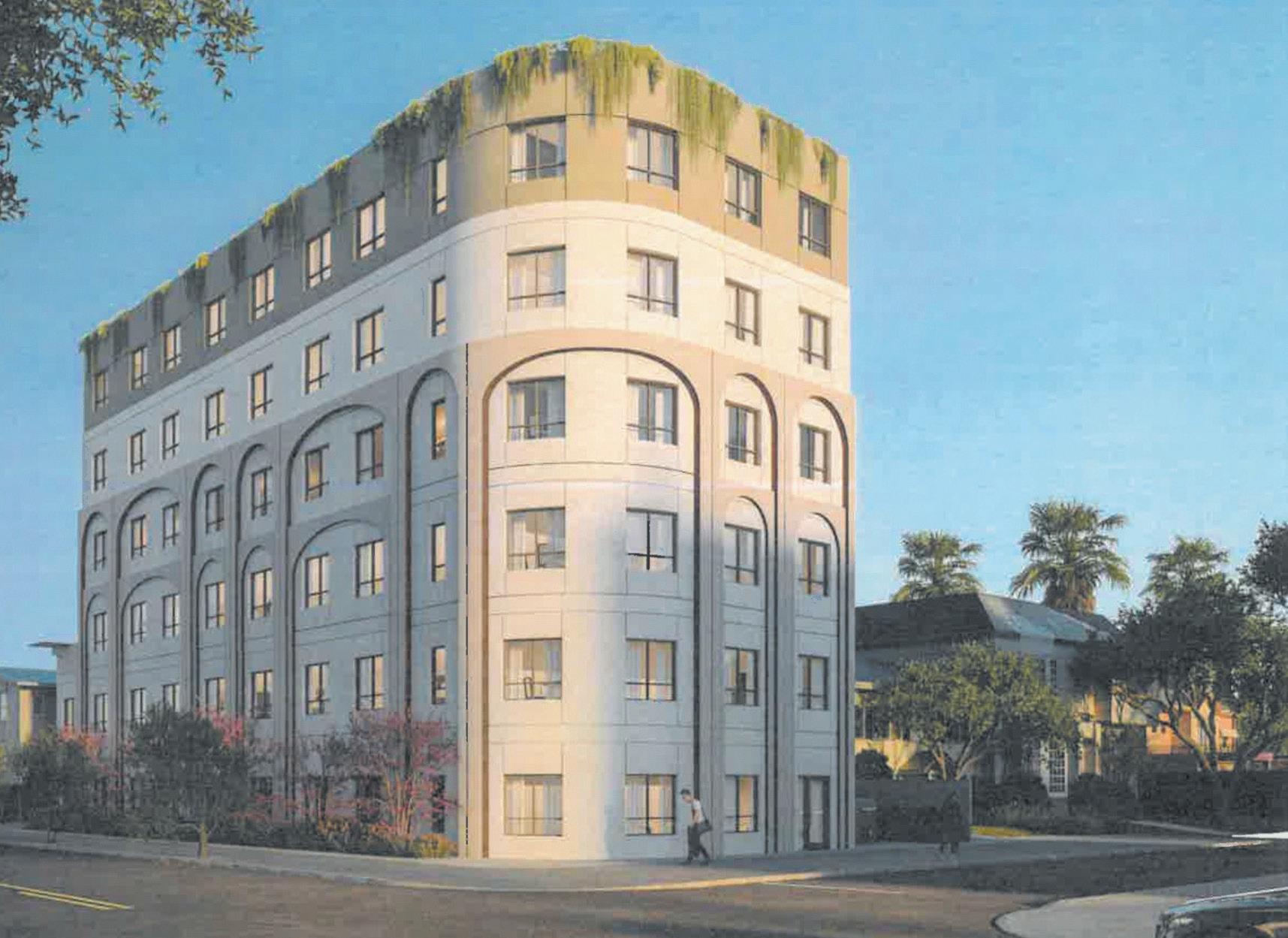
SIX-STORY APARTMENT BUILDING approved for erection by City Planning, right next to single-family homes on Lorraine Boulevard in the Windsor Village HPOZ. Rendering from Kevin Tsai Architecture
ed that the City is not more rigorous in its interpretation of the existing Windsor Village Preservation Plan. There are many quantifiable standards in this plan that are not being enforced. State law clearly allows this enforcement. If the plan was enforced, this would be a very different and maybe even welcome project.”
Kaliski also is a former board member of the Windsor Village HPOZ. Because the project is within one-half mile of a major transit stop (Wilshire and Crenshaw), it received a
Cecile Keshishian, well known for her passion and activism for both the Armenian community and those less fortunate than herself, has died at the age of 90. She died of pneumonia on May 27 in Los Angeles.
Keshishian, née Simonian, was born on April 30, 1934 in Antioch, Turkey, and grew up in Beirut, Lebanon. Her parents were both survivors of the Armenian Genocide. She was the second of their four children.
The family planned to relocate to Armenia after World War II. But the transport ship sank before arriving in Beirut, so the family stayed in Lebanon.
For her secondary education Cecile attended the Melkonian Educational Institute, a boarding school on the island of Cyprus. She was a star basketball player, a medical volunteer, a student leader, and one of four teenagers chosen to represent Cyprus at the coronation of Queen Elizabeth II in England in 1953.
After graduating from Melkonian, she returned to Beirut and began work as an executive assistant at Canada Dry International at a time when the company was expanding into the Middle East. In her spare time, she was a founder and early leader of the Girl Scouts movement in Beirut. During this same time, she met and became engaged to Dr. Kevork Keshishian. They married on Oct. 1, 1960.
Both of the couple’s children, Alek and Aleen, were born in Beirut. In
height increase of up to three stories, according to the 45page Letter of Compliance.
The project was allowed five incentives and one waiver, which included a 66.7 percent reduction of the required northerly side yard from nine feet to three.
After the 64-unit project was deemed complete on April 18, the City had 60 days to issue the Letter of Compliance.
The Kevin Tsai Architecture-designed, Brown Stone Capital, project includes studio and one-bedroom units and zero on-site parking. It
was approved as a 100-percent affordable housing project. Interim control?
Partly in response to this project, Councilmember Katy Yaroslavsky in April introduced a City Council motion requesting a citywide Interim Control Ordinance (ICO) that would put the brakes on these types of projects in single-family neighborhoods and the city’s 35 HPOZs.
The ICO motion is expected to go before the City Council’s Planning and Land Use Management (PLUM) Committee prior to a final vote on the proposal by the full City Council. No hearing dates have been set. Where is ED 1 now?
Community groups have been hopeful the mayor would revise her Executive Directive to close loopholes and stem streamlining for projects that are out of character with neighborhoods.
But now, however, the tide seems to be turning towards YIMBY housing groups who are “pushing to codify ED 1 with no concern for guidelines
April 30, 1934 – May 27, 2024
1968, the young family moved to the United States, settling first in Brookline, MA, and later in Manchester, NH, where Dr. Keshishian worked as a board-certified radiologist.
In Manchester, Cecile completed her college education at Notre Dame College, graduating magna cum laude with a double degree in Business and American History.

She served as president of the volunteer organization Catholic Medical Center Hospital Associates, which had 600 members. Later she served as president of the New Hampshire Medical Auxiliary. She was a founder of the New Hampshire Good Samaritans Suicide Prevention Hotline and a board member of the American Children’s Theatre.
Dr. & Mrs. Keshishian regularly opened their Manchester home to friends, relatives, and newly arrived immigrants for months at a time. Cecile helped find lodging, furniture, jobs, and schools for immigrants she knew and for some she was meeting for the first time. She also taught Armenian language and history to her own children and to other young Ar-
menians in New England. She herself was fluent in five languages – Armenian, French, Arabic, Turkish, and English. In 2005, Cecile received the Ellis Island Medal of Honor, the only award of its kind sanctioned by both the U.S. Senate and House of Representatives. The award honors American citizens who distinguish themselves and make a profound impact in the lives of others. Past honorees have included Ronald Reagan, Muhammad Ali, Sandra Day O’Connor, Rosa Parks, and Hillary Clinton.
Throughout their 58-year marriage, Cecile and her husband were leaders in Armenian-American organizations and causes, including the Armenian General Benevolent Union (AGBU) and the Armenian International Women’s Association (AIWA), among others. They helped fund a student center at the American University of Armenia. The facility was named in their honor. On the occasion of its opening, Mrs. Keshishian told students: “Take advantage of your incredible blessings and get the most out of your education, both inside and
that — without adding them — can negatively impact our communities, environment, and the people who will lose rent stabilized units,” leaders of United Neighbors wrote in a June 12 email to communities across the city.
The coalition of neighborhood residential groups is encouraging members of the community to send letters to their representatives on the City Council.
“We feel the best use of everyone’s time is sending thousands of letters in support of guidelines, again to three important players,” the group wrote to area residents. They are your council member, PLUM Chair Marqueese Harris-Dawson and PLUM members Imelda Padilla, John Lee, Katy Yaroslavsky and Heather Hutt.
A sample letter encourages common sense guidelines that “will allow ED 1 projects that are worth an expedited fast-track planning approval while more problematic projects will require discretionary review.
“Adding more affordable housing does not have to come at the cost of protecting our communities, environment and rent stabilized housing.”
outside the classroom. I am 88 years old and still continue to learn something new daily – learning keeps one young. Knowledge is power.”
In 2000, she and her husband moved to Los Angeles to be closer to: their children, filmmaker Alek and talent manager Aleen; their attorney son-in-law Kit Troyer; and their grandchildren Lulu and Jesse Troyer. Cecile was enormously proud of them for their character and accomplishments, especially that all five were graduates or current students at Harvard University. She was a longtime Hancock Park resident, living in the El Royale for over 20 years.
Mrs. K, as many in the community knew her, was a docent and member of the Windsor Square Historical Society.
Cecile’s beloved husband died in 2018. She is survived by her brother Dr. Simon Simonian, sisters Rita Balian and Annie Totah, her nieces and nephews along with their spouses and children, her son Alek Keshishian and daughter Aleen Keshishian, her son-in-law Kit Troyer, and her granddaughter Lulu Troyer and grandson Jesse Troyer.
In lieu of flowers, the family has established a memorial fund in Mrs. Keshishian’s name at the Armenian General Benevolent Union. Contributions may be made at agbu.org/ memory-cecile-keshishian or mailed to: AGBU, 55 East 59th St., New York, NY 10022, with “Cecile Keshishian” on the check’s memo line. Adv.

By Suzan Filipek
A real estate development firm submitted an application for a mixed-use apartment complex at 6721-6727 Melrose Ave. (at Mansfield Avenue) to the Los Angeles Dept. of City Planning in April.
Plans by applicant Vitruvian Development Group call for a six-story building with 27 one- and two-bedroom apart-
ments with 519 square feet of ground-floor commercial space. A partially subterranean parking garage will have 22 vehicle stalls. The corner lot is two blocks
By Suzan Filipek
Concerns about parking, noise and security were among issues raised at an online hearing last month on a conditional use beverage permit application for the proposed Pawn Shop sports bar at 5901 Melrose Ave. The proposed new restaurant is named after the pawnshop previously on the site.
More than 100 people attended the hearing for the Ventana Ventures redevelopment of the 7,808 square-foot, two-story property into a 260seat restaurant.
Proposed operating hours for the bar are 6 a.m. to 2
a.m., daily. No on-site parking is proposed.
City Planning Dept. Associate Zoning Administrator Jack Chiang said he liked the redevelopment and its design overall. But he asked the applicant to address the community concerns before he completed his review and approved the project.
The Hancock Park Homeowners Association sent out an email following the hearing thanking those who attended.
“Our requests are reasonable and help ensure that our neighborhoods’ safety and quality of life are protected,

while having a new business join the community,” wrote HPHOA President Cindy Chvatal-Keane and board member Mark Alpers.
Homeowner Sam Uretsky, resident in the Larchmont Village Neighborhood Association area, also sent out an email after the hearing: “The developer has not budged from his overreach on hours and requests for even more intrusive special events. He has done nothing to address a parking plan, a plan for security in and around the premises, or a plan for noise abatement. He will not commit to annual or emergency meetings with the community to review and remedy ongoing or new concerns at the property.”
Uretsky did state that Zoning Administrator Chiang held a fair hearing and asked the applicant to: reconsider its extended hours of operation with full alcohol service in light of the community’s insistence that the hours be kept to neighborhood norm of 11 a.m. to 11 p.m. and submit a security plan, a parking plan and a plan for noise containment within the structure.
“Keep in mind that if this project goes through as planned, it will set precedent all along Melrose from Highland to Wilton Place,” Uretsky said. “This will have serious consequences across Larchmont’s northern border and might well influence bar and restaurant hours on Upper Larchmont.”
Final findings on the CUB

west of Highland Avenue. A vacant commercial building is on the site now.
The developer has asked for entitlements to include a density bonus to build a larger structure than allowed under zoning laws. In exchange, three of the 27 apartments would be very-low-income affordable housing.
The project is just one of many multi-family housing projects being developed nearby on Melrose Avenue.
At the southwest corner of
Melrose and La Brea avenues, a 33-unit mixed-use building is planned. Further east on Melrose, on the northeast corner of Highland, another 33-unit mixed-use building opened in 2022. Also recently applied for at the Dept. of City Planning is a residential-retail complex at 8251 Melrose Ave. in Beverly Grove. If approved, a six-story building with 90 apartments above 16,000 square feet of ground-floor retail will replace three small one- and two-story commercial buildings.

(Continued from Page 3)
Buildings Code, which offers further code flexibility. With Los Angeles having reached historic office vacancy rates of greater than 15 percent (26 percent in DTLA) the pool for adaptive reuse projects has vastly expanded.
Challenges
Adaptive reuse is not without its challenges, however. Not all commercial and office structures are suitable for residential use. Office buildings’ architectural programming and construction can make them difficult and even cost-prohibitive to reuse without financial incentives or subsidies. Other concerns include underlying zoning
(Continued from Page 6) permit/conditions are expected in July.
The Chronicle received a response from Diego Torres-Palma, managing partner at Ventana Ventures, after the hearing:
“As a resident of Windsor Square, I know how special our neighborhood is. The Pawn Shop will only enrich our community as a gathering place where the entire family can watch live sport-
difficulties and lack of 24-hour and residential amenities in commercial districts. Los Angeles’ foresight in utilizing its adaptive reuse programs for a quarter century leaves the city’s reuse candidate pool for suitable conversions higher than in many other cities.
Sustainability also is a factor driving adaptive reuse, and preservationists repeatedly make the case quoting architect Carl Elefante, who said, “The greenest building is the one that is already built.” Even the City Planning Department’s fact sheet on its new ordinance states, “[With even] the most energy-efficient new construction, ... [it] can take up to 80 years to recover the energy that went into the demolition,
ing events and enjoy food from a James Beard-awardwinning chef.”
He added, “By preserving the exterior of the building and keeping its name, we honor our past while embracing the future. We appreciate all the support from our community, and to acknowledge concerns about parking and hours, we are adjusting our hours and solidifying valet and security plans to alleviate any neighborhood concerns.”
The remodeling design by architecture firm Omgivning
production, manufacture, and transport of new building materials.” Even starchitect Lord Norman Foster, who recently established an office in Los Angeles and who is designing projects in Beverly Hills and Hollywood, weighed in: “The ultimately sustainable building is a building that you can recycle. Instead of demolishing the building, you can adapt it to change.”
The proposed Citywide Adaptive Reuse Ordinance is a hopeful sign amid repeated assaults from Sacramento on preservation values. Last month, California’s preservation community was called to mobilize in opposition to Assembly Bill 2580, which seeks to besmirch the historic preservation movement — and, by
will maintain the size of the existing building and restore and enhance its architectural details, according to city documents.
The project’s tentative name is in homage to the former Brothers Collateral pawnshop at the site. The two-story canary yellow shop was run by Rudy Gintel, of Hancock Park, and his brother, Ernest Gintel, for more than 40 years, until 2020.
Built in 1934, the building was a Cut Rate Drugs store in its earlier life.
extension, its supporters — as a barrier to housing and a branch of NIMBYism deserving of being viewed and monitored as suspect in future Housing Elements. Policies like the City’s new ordinance counter that false narrative and endeavor to use preservation as an ally in housing policy to secure the goal of an affordable Los Angeles for all, while at the same time preserving our history and sense of place.


By Casey Russell
The Hollywood Heritage Museum’s newest exhibit, “Out With the Stars,” opens Mon., June 29.
The exhibit includes vintage menus, uniforms, historic signs, photos and décor from restaurants and hangouts frequented by classic Hollywood stars and Larchmont Chronicle readers. “We wanted to show Hollywood haunts — places you would’ve gone back in the day,” said Darin Barnes, museum co-curator.
Many of the establishments of the ’20s, ’30s, ’40s and ’50s, which are highlighted by the museum, have long since closed. However, El Cholo,


which was founded in 1923, is still going strong. The exhibit features an old neon sign from the restaurant.
Memorabilia from the Brown Derby, the Cocoanut Grove and the Ambassador Hotel are combined in one area, and the museum even managed to find and display a uniform worn by the hotel’s front-of-house person and two elevator operator uniforms worn by women working at the hotel — most likely during World War II.
Tiki-related restaurant ephemera, including items from Trader Vic’s and the Pirate’s Den are in an area adorned with tiki lights, and local favorite Don the Beachcomber is not overlooked. The
main gallery features a tribute to the restaurant Hollywood Canteen.
“We think we came across the single largest collection of Hollywood Canteen memorabilia. It has never before been displayed,” said Barnes. The curator told us that museum-goers will see wristbands, paper cups, cigarettes, photos and ashtrays among thousands of pieces.
During these classic Hollywood decades, locals would go to the Brown Derby to dine, but also for a chance to see stars. The Brown Derby’s original location was on Wilshire, but there was also one on Vine Street, just south of Hollywood Boulevard.

Hollywood Heritage’s exhibit includes the sign from the Brown Derby Coffee Shop, which adjoined the Vine Street restaurant.
“Come and revisit your past a bit! You’ll see the plates you and the celebrities would’ve eaten off of,” said Barnes. A score of restaurants, bars and hotels are included in the
exhibit, and the vintage memorabilia will whisk visitors back to this classic time of our city’s history.
For more information, visit hollywoodheritage.org. Hollywood Heritage Museum is at 2100 Highland Ave., right across Highland Ave. from the entrance to the Hollywood Bowl.

By Nona Sue Friedman
The Greater Miracle Mile Chamber of Commerce (GMMCC) and Council District 5 officially welcomed Andre’s Italian Restaurant, 5400 Wilshire Blvd., to the neighborhood in late May. Attendees were treated to menu specialties such as spaghetti and meatballs,
eggplant Parmesan and roasted chicken.
At the ceremony on the Wilshire Boulevard sidewalk, Thao Tran, field deputy for CD 5, presented Stephanie Gagliarducci, co-owner of the restaurant and grandniece of the original Andre (born Dominic Andreone), a certificate of recognition
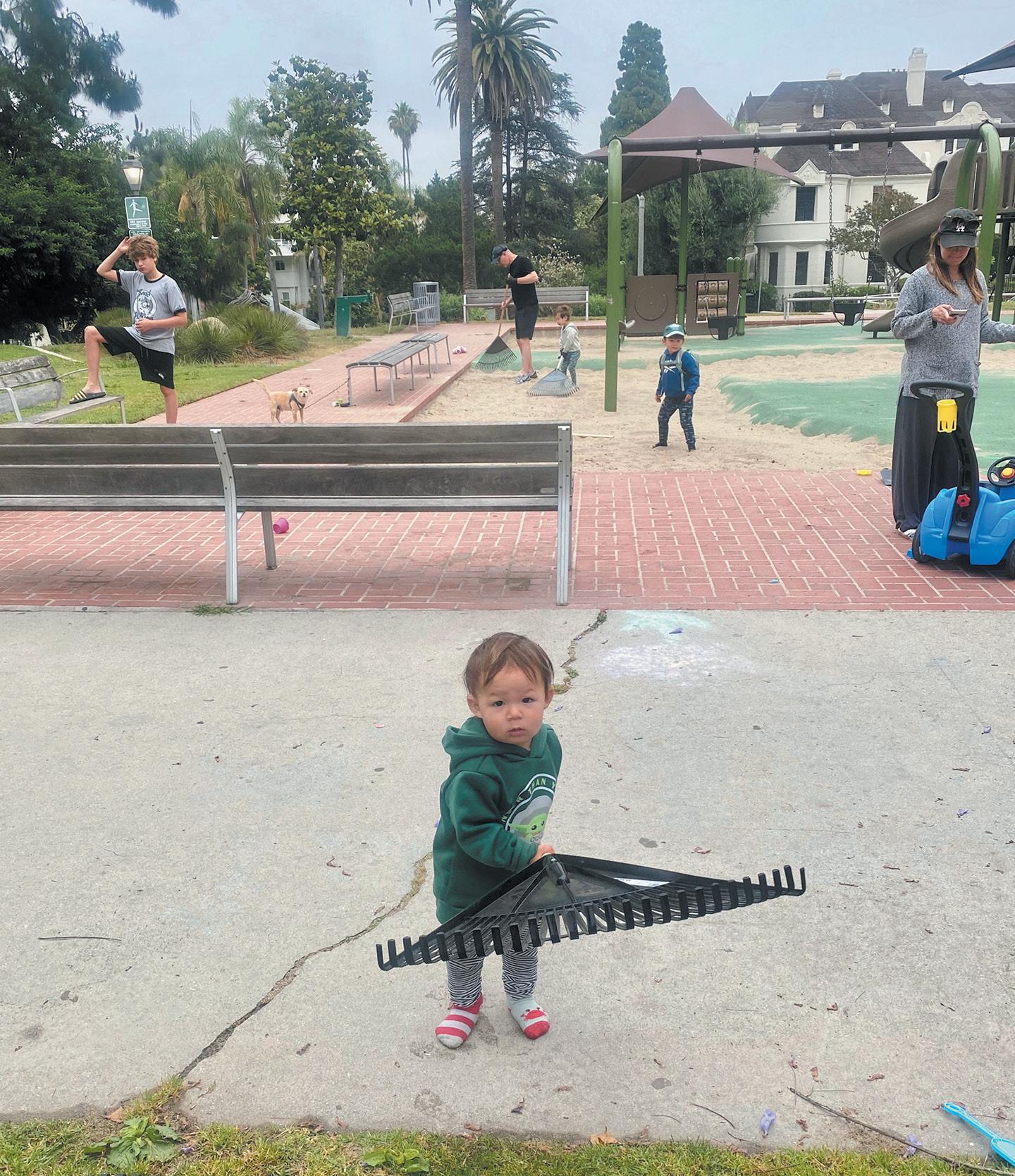
from the City of Los Angeles. Also accepting recognition were co-owner and chef Simon Alvarez and Gagliarducci’s brother, Nicholas.
Andre’s had been a staple in the Town and Country shopping center at Fairfax Avenue and Third Street for decades, serving good Italian food in abundance at an affordable price. It closed in July 2022 when the building was sold and torn down for the new housing and retail project rising there now.
“Town and Country’s loss is Miracle Mile’s gain,” said Portia Park, of GMMCC.
It took Gagliarducci one year, eight months and 19 days to find and renovate the current location. This is the third venue for Andre’s. The first one, Andre’s of Beverly Hills, was also on Wilshire.
“Now the restaurant is back on Wilshire; it’s come full circle,” says Gagliarducci. Her brother, Nicholas, is a muralist, and he decorated the walls with beautiful depictions of the restaurant’s history.
When asked how the transition to the new locale was faring, Gagliarducci responded, “Business has been going very well, and the customers are amazing, so loyal.”



By Casey Russell
In an effort to keep their homeowners association (HOA) fees stable, residents living in the 29-unit, three-story condominium at 4407 Francis Ave. (in Windsor Village) took advantage of a rebate program offered through the Los Angeles Department of Water and Power (LADWP). Board members were aware that a significant chunk of HOA fees paid the water bills.
“We have this long parkway, and the grass covering it wasn’t even taking in water,” board member Lia Aquino told us. The parkway runs for half of the block between Lucerne and Windsor boulevards. Sprinklers were set to water the parkway’s grass three times per week, but much of the water would just flow out into the street. Aquino read about water saving projects on LADWP’s website, and she discovered a turf replacement program that fit the condominium’s needs.
DIY Board members first got an estimate from an environmental design firm that promoted planting native plants. But the $21,000 estimate was too high for tenants to cover. Fortunately, the company’s owner suggested that residents “do

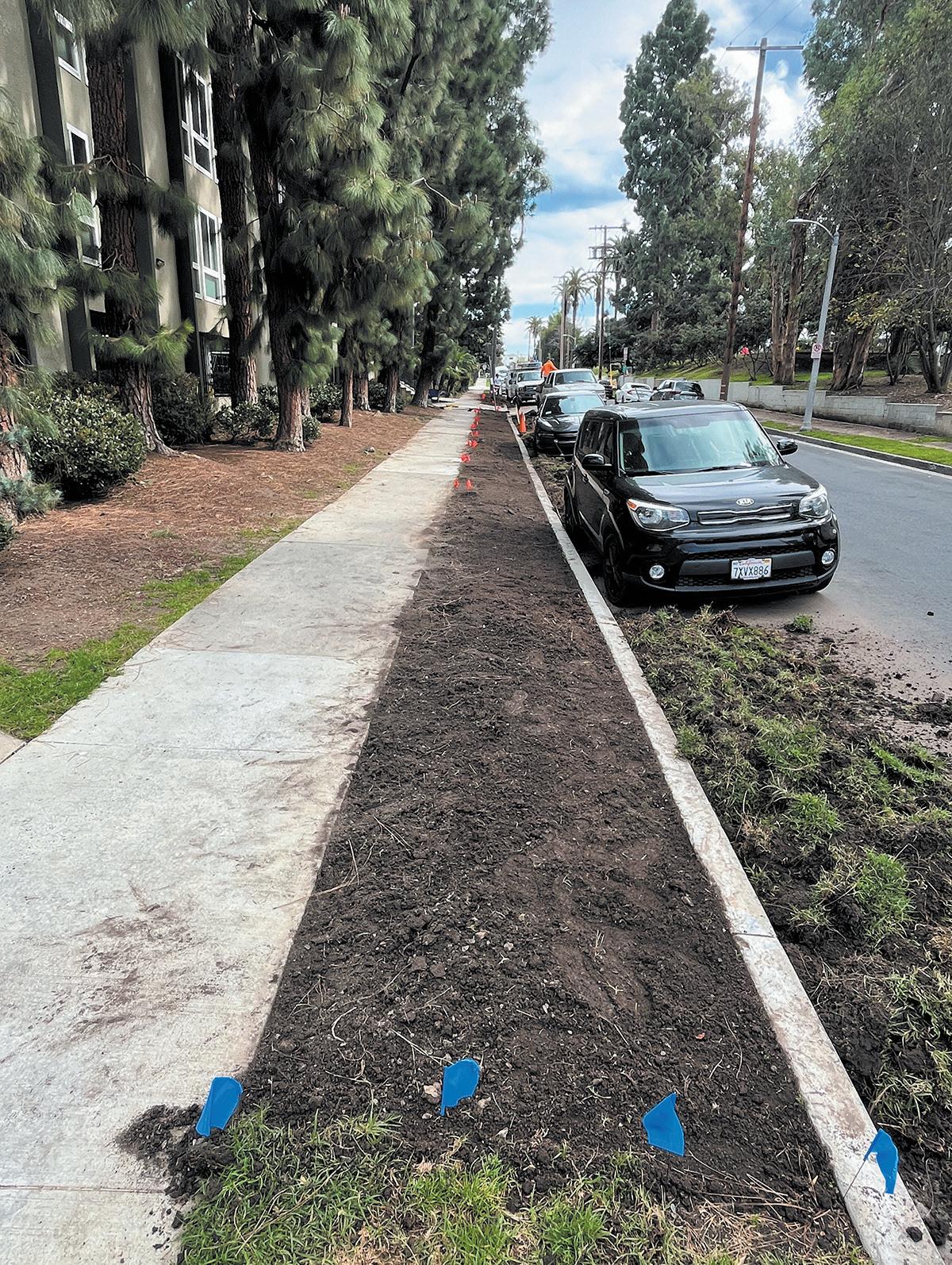
it themselves,” and said she’d be happy to offer advice and answer questions for a DIY project.
“It took us two years to get the funds and plans together,” said Aquino. She and a fellow board member went to the free turf replacement classes offered through LADWP. They learned how to remove turf, replenish and mulch and which plants were appropriate to use.
When residents commenced work, the process took five months because of various challenges. Aquino said that a crew of five people doing this for a living probably could have done the project in a weekend. But, with a small number of volunteers — many of whom had never done any gardening — compost delivery delays, and rain on some chosen workdays, it
took the DIYers more time and “a lot of sweat equity!”
The volunteers who did the project were a mix of owners and renters. People who couldn’t physically do the digging brought water to those who were. “It was a good way to spend a significant amount of time getting to know others in the building,” said Aquino. Those who did participate gained a new respect for gardeners. “We were like,
‘Oh, my God! This is so hard!’” Aquino said she skipped Pilates for two and a half weeks because she was getting her planks in while outside on the parkway. Neighborhood walkers and park-goers (Harold Henry Park is just across the street) cheered the group on. They’d say, “You’re doing such a great job!” said Aquino.
Variety of plants
The Windsor Village residents chose plants that would bloom at different times of the year to bring variations in color to the parkway. Aquino especially loves the California poppies, yarrow and milkweed that were planted. She had never seen poppies in person and appreciates that the association’s parkway now provides monarch butterflies with the one plant they will lay their eggs on — milkweed. She hopes her building’s project encourages people living in other multi-unit dwellings to consider doing something similar. “I know people will keep building and living in this city, but our pollinators can still thrive if we give them these little micro spaces. It doesn’t have to be us versus them. There are a lot of beautiful native plants that give beautiful blooms
(Please turn to Page 11)

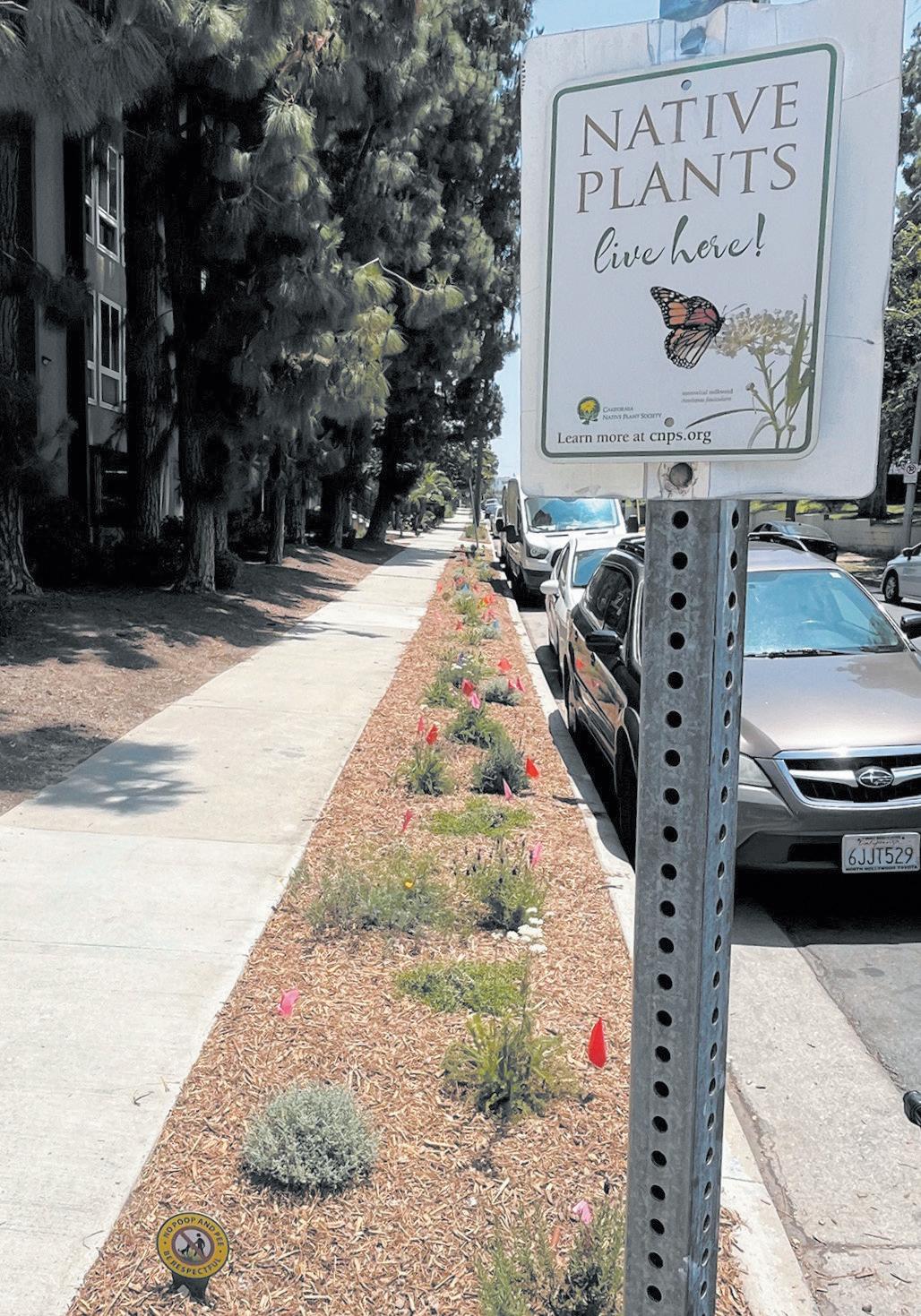
in the refurbished parkway at 4407 Francis Avenue.
(Continued from Page 10)
and that our pollinators, animals and birds can benefit from.”
Board members documented each step of the process, and a representative of the program officially checked that all the city rebate requirements had been met. The project cost the HOA $10,000, and they are looking at a $4,000 rebate.
Reduced bills
Already, the parkway watering has gone from three times to one time per week. When
the plants reach maturity, they should only need to be watered once per month. That’s a big difference for the building’s water bills and for Southern California’s water supply. As part of the program’s requirement, a drip irrigation system was installed which uses significantly less water. Water is no longer running out onto the street, but instead directly down into the roots of the plants.
Point of interest
The new planting in the condo parkway garden has become a point of interest in the community. Aquino says that she often sees people stopping to take pictures of the flowers growing there. She squealed with joy when she noticed “Oh my God! A butterfly just landed on the milkweed!”
Learn about rebates through the LADWP and Metropolitan Water District of Southern California SoCal Water Smart Rebate Program at socalwatersmart.com, or call 800-544-4498. (Select option five for parkways.)
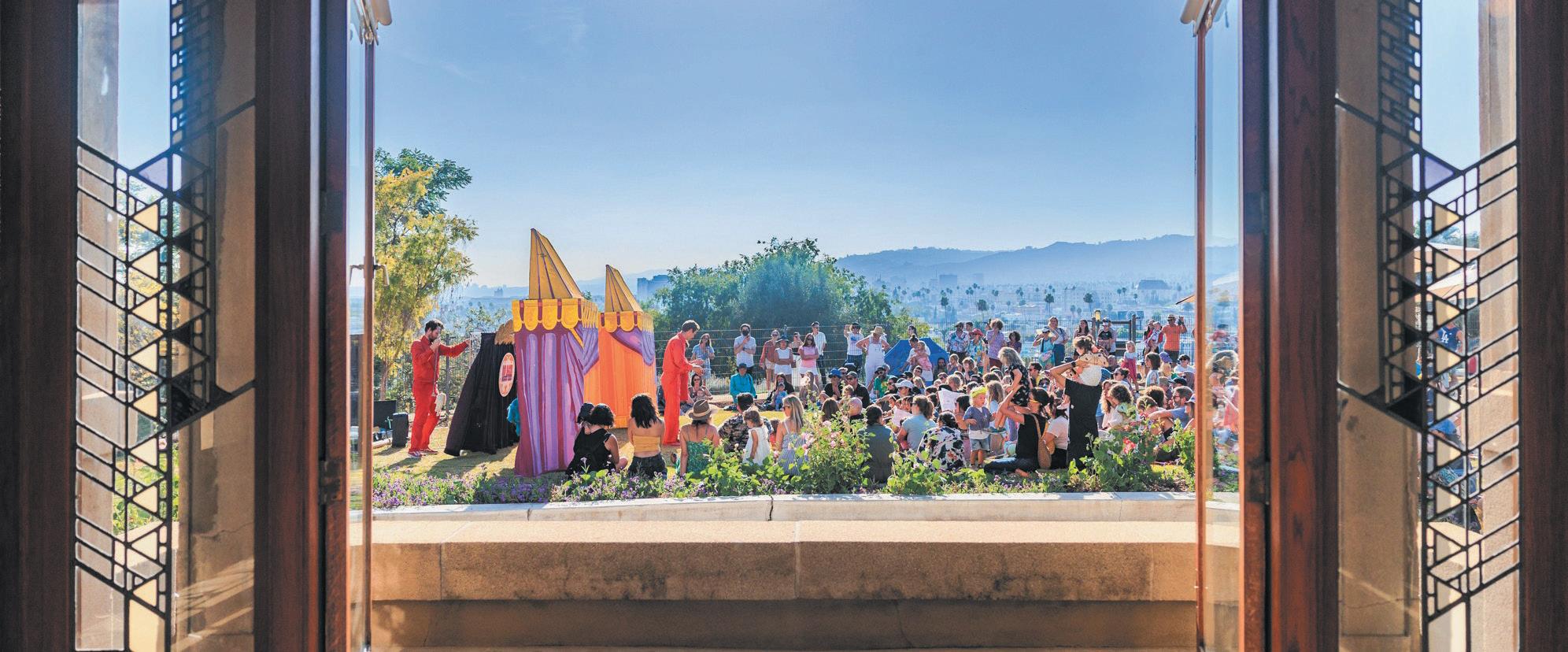
By Nona Sue Friedman
Grab a blanket and watch a Bob Baker Marionette Theater (BBMT) performance for free. These ticketless outdoor events, “Puppets in the Park,” take place on the west lawn of the historic Hollyhock House, designed by Frank Lloyd Wright and completed in 1921, at 4800 Hollywood Blvd. Upcoming shows are Saturdays, July 13, Sept. 14 and Oct. 12.
In July, BBMT will perform “Circus;” September is “Hooray LA;” and October is “Halloween Spooktacular.” Gates to the lawn open at 9:30 a.m., and shows start at 10 a.m. After the show, create with a free family-friendly art activity at
10:30 a.m. More information is available at bobbakermarionettetheater.com
Hollyhock House is a UNESCO World Heritage Site and a National Historic Landmark. The compound was commissioned by oil heiress and theater producer Aline Barnsdall, who donated it to the City of Los Angeles in 1927.
FAIRFAX
Self-guided tours are offered the day of the performances. Purchase tour tickets, $3 to $7 each, in advance at hollyhockhouse.org.
161 S. Gardner St. 323-936-6191
JOHN C. FREMONT 6121 Melrose Ave. 323-962-3521
MEMORIAL 4625 W. Olympic Blvd. 323-938-2732
WILSHIRE
149 N. St. Andrews Pl. 323-957-4550
HOURS Mon. and Wed., 10 a.m. to 8 p.m.; Tues. and Thurs. noon to 8 p.m.; Fri. and Sat., 9:30 a.m. to 5:30 p.m. Libraries will be closed Thurs., July 4.

By Casey Russell
Pan Pacific Park was the venue for 2024’s Tarfest, the free music and art festival for people of all ages, on June 15. The sun shined down and music greeted the 2,000 people who spent the afternoon strolling among booths set up on the park’s grassy area south of the gymnasium buildings and parking lot.
Art installations, gourmet food trucks, and an artisan marketplace with 18 vendors and multiple activities such as face painting, balloon art and crafting opportunities kept festivalgoers entertained at the 21st Tarfest. Held for its first 19 years adjacent to the La Brea Tar Pits, the festival has been

welcomed, last year and this, in Pan Pacific Park during the construction underway at the Los Angeles County Museum of Art (LACMA).
Featured this year were hiphop breakdancing workshops and cultural activities run by the Korean Cultural Center and booths from the Japan
Foundation. There were eight participating local museums in all, including the Academy Museum of Motion Pictures and Holocaust Museum LA. The event included an active kids/family area as well as several cultural organizations and nonprofits on site, said James Panozzo, executive director of event sponsor Launch LA.
By Casey Russell
Holocaust Museum LA (HMLA) is closed through Mon., Nov. 11, due to construction of its new wing, but programming will continue off-site and online this summer.
Teens in grades 7 through 12 can participate in the Voices of History Film Workshop,



which will take place Mon., July 15, through Fri., July 26, from 10 a.m. to 2 p.m. at the Milken Community School.
Online offerings will include an exploration of the cultural history of Jewish clothes through the ages on Mondays, July 15, 22 and 29, at 6:30 p.m. Additionally, there will be opportunities to hear Holocaust survivors speak about their experiences on Sundays at 3 p.m.
“Son of Saul,” the first of five resistance-themed films, can be viewed online Thurs., Aug 1, at 6:30 p.m. The Teicholz series’ remaining four films will screen at AMC The Grove 14, Thursdays, Aug. 8 through Aug. 22, at 6:30 p.m. Films will include: “They Fought Back,” “Who Will Remain?” and “The Auschwitz Report.”
Award-winning journalist and producer Tom Teicholz will moderate panel discussions following each screening. Founded in 1961 by survivors of the Holocaust, HMLA is undergoing an expansion that which will double its space in Pan Pacific Park. The existing structure’s interior will remain much the same, but a rooftop pavilion is being built. It will house a boxcar (used to transport Jewish families) that was unearthed outside of Majdanek death camp in Poland and that was donated to the museum.
Award-winning architect Hagy Belzberg, who also designed the current museum, has designed the addition.
When work is finished, Holocaust Museum LA will be





By Nona Sue Friedman Senior Lead Officer (SLO)
Joe Pelayo is retiring at the end of June after being part of the neighborhood for the last 17 years. His own community police station, the Olympic Division of the Los Angeles Police Department (LAPD), along with the Wilshire Rotary Club, celebrated his service to the city last month.
LAPD Olympic farewell Olympic Community Police Station was abuzz with hugs, farewells and good wishes for Pelayo at his official retirement party held there on June 18.
The station hosted a party with tacos, agua frescas and cake in a room filled with officers from many stations throughout the city, family members and community residents including Bob Reeves, president of Ridgewood Wilton Neighborhood Association, and Michael Soriano, from the Larchmont Village neighborhood.
Colleagues were gracious when they spoke about Pelayo. His former captain, Ed Sun, said, “He’s very even-keeled; nothing ever bugged him and he’s so easy-going.” LAPD Chaplain Francis Hicks commented, “He’s an instrument



of love for the community who fosters friendship and understanding.”
Eric Mollinedo was in the same academy class and at the same station as Pelayo for years. Mollinedo remembers the first time he noticed Pelayo during their training. The commanding officer said, “Going to a rock concert? Your hair is too long.” They became friends, and Mollinedo introduced Pelayo to biking, which has since become an obsession.
SLO Danny Chavez, who is taking over Pelayo’s patrol area, says, “I wouldn’t be an SLO if it wasn’t for you. Joe’s an excellent mentor and the
big brother I never had. I’m really going to miss you.”
Pelayo, who at points teared up, told attendees, “Being in the LAPD has been an amazing journey. I’ve seen it all, good and bad. When I travel back east for the bike rides, the other officers always admire us. It’s been a great
career and community. I will miss you. Thank you.” He said he still plans on coming around the neighborhood on occasion and stopping in at Peet’s on Larchmont.
The event was capped off with a flyover by the regular LAPD helicopter patrol. From the loudspeaker in the copter,
officers congratulated Pelayo on his tenure and retirement. Wilshire Rotary
Our local Rotarians earlier had honored Pelayo’s positive impacts in our neighborhoods at a luncheon at the Ebell of Los Angeles, 743 S. Lucerne Blvd., on June 5.
Wendy Clifford, a Rotarian and resident of Windsor Square, gave a touching toast about Pelayo, her SLO. She noted that he has been an
(Please turn to Page 14)



OLYMPIC DIVISION
Senior Lead Officer (SLO) Joe Pelayo said in his final report that crime in the area has been quiet for the last few weeks and that burglaries were down for the first time in months.
ROAD RAGE: A male suspect exited his car and punched a victim in the face before fleeing the scene at
(Continued from Page 13)
LAPD officer for 29 years — not looking his age [59 years] at all, and she asked him, “Where is the fountain of youth? I need it.”
Clifford recounted seeing Pelayo recently at the Larchmont Village block party in April. He strolled through
Melrose Avenue and Irving Boulevard on June 9.
AGGRAVATED ASSAULT:
While walking down the street, a Black male hit a victim with a metal pole on Wilshire Boulevard near Lorraine Boulevard on June 10.
THEFT: A suspect cut and removed wiring from the outside of the fire station at 4029
the crowd greeting residents, getting and giving hugs, and hearing words of farewell. Clifford thought, “Oh, my — he’s a rock star in the neighborhood!”
At the luncheon, Clifford spoke of president of the Larchmont Village Neighborhood Association (LVNA), Charles D’Atri’s, “admiration for [Pelayo’s]
Wilshire Blvd. on June 1. ATTEMPTED GRAND
THEFT AUTO: A suspect tried to steal a car on June 1 from the 600 South block of St. Andrews Place.
WILSHIRE DIVISION
This division was unable to give its monthly crime information to the Chronicle before we went to press.
steady calm, creative thinking and wicked sense of humor.” D’Atri had recounted a story about Pelayo coming to an LVNA meeting where he set a big pile of random belongings including purses, laptops, shoes and cell phones on a table, and said, “This is what happens when you don’t lock your car.”


by
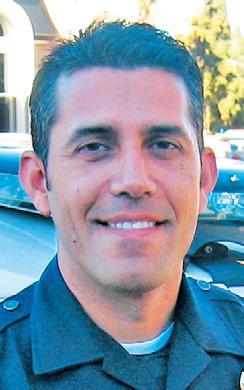



In 1986, The New York Times announced the adoption of the honorific “Ms.,” citing it as an alternative to “Mrs.” and “Miss” that does not specify a woman’s marital status. The notice came 85 years after an unnamed author wrote in to The Sunday Republican of Springfield, Massachusetts, proposing that the then unfamiliar abbreviation be incorporated in modern terminology. “Everyone has been put in an embarrassing position by ignorance of the status of some woman. To call a maiden Mrs. is only a shade worse than to insult a matron with the inferior title Miss. Yet it is not always easy to know the facts,” the writer argued.
Another development in “Ms.” advocacy came in 1961, when a 22-year-old civil rights worker named Sheila Michaels spotted the title on a piece of mail addressed to her roommate, a chance encoun-

(Continued from Page 12)
much more noticeable along The Grove Drive. The new Jona Goldrich Campus, as it is being dubbed, will allow the museum to offer more public workshops and stu-


ter that she initially took as a typo. Michaels began lobbying for use of the title, seeing the egalitarian potential in its ambiguity. During an interview on New York’s WBAI radio around 1969, Michaels made the case for “Ms.” in a plea that caught the ear of a friend of Gloria Steinem, who suggested it as the title for Steinem’s new feminist magazine — the country’s first. Steinem’s Ms. magazine debuted in 1971.
“Ms.” and the other titles of courtesy that might precede a woman’s surname originated as abbreviations of “mistress.”
Though the prevailing definition for the word “mistress” today has a disreputable intimation, “Mrs.” and “Miss” were developed in the 16th century, when “mistress” was used to describe a broad range of women, including those who had “power, authority or ownership.”
The male counterpart for
(Continued from Page 14)
with an engraved wooden cheese board from Wilshire Rotary. When he thanked the community and his LAPD work family, he choked up. “Thank you” was all he could muster. Seems like he’s going to miss his job as much as the neighborhood is going to miss him.
The Larchmont Chronicle joins the chorus saying “Farewell, Joe Pelayo, and thank you for your service!”
dent tours, and it will include a learning center pavilion that will house a 200-seat theater, outdoor spaces, two classrooms and more exhibit space. Considering that the number of museum visitors has increased by 400 percent in the last 13 years, the added space will fulfill a vital need.
Visit hmla.org/upcoming to learn event details. Contact rachel@hmla.org regarding teen programming.

Mara Fisher

these designations, “Mr.,” of course makes no inquiry into a man’s domestic situation. When the abbreviation first appeared in the middle of the 15th century, it stood for “master” and was pronounced as such. From the 16th century onward, the vowel became altered, resulting in the variant used today — “mister.”
More than one “Mr.” makes up “Messrs.,” an English abbreviation borrowed from the French “messieurs,” the plural form of “monsieur.” The French honorific is formed from “mon” (or “my”) and “sieur” (meaning “lord”). Diving into “sieur” (which also begets the English “sir”) we arrive at the Latin “senior,” an adjective meaning “older.”
“Mr.” was also chosen as the manner of address for the first U.S. president in 1789 — though not without debate.
Vice President John Adams first encouraged the use of “Highness,” later revising his recommendation to “Majesty,” a proposal deemed by Thomas Jefferson to be “the most superlatively ridiculous thing I ever heard of.” Benjamin Franklin chimed in that it was “absolutely mad.” George Washington, who had initially favored the title “His High Mightiness, the President of the United States and Protector of Their Liberties,” heard the criticism that such titles smacked of monarchy, and he immediately changed his mind. The simple title of “Mr. President” was thus crystallized.
Whereas “Ms.” deemphasizes a woman’s marital status and thereby asserts an even counterpart to the male “Mr.,” a more recent advent, “Mx.,” avoids assumptions about gender altogether.
Pronounced “mix” or “mux,” the most widely used gender-inclusive honorific first appeared in the 1970s and is believed to have influenced the use of the gender-neutral “-x” suffix in “Latinx.”
“Mx.” made waves when it appeared in a 2015 article in The New York Times, though the publication has yet to announce its inclusion into its newsroom’s style manual. That being said, the two-letter title does appear to have legs. It was added to the Oxford English Dictionary, also in 2015. In the United Kingdom, Mx. is recognized by the Royal Mail, some government agencies and most major banks. And back on this side of the pond, those visiting the White House website’s contact page may choose their preferred prefix from a dropdown menu that lists “Mr.,” “Ms.,” “Mrs.,” “Dr.” — and “Mx.” — when writing to “Mr.” President. Personally, I’m fine with any of them — just don’t call me “ma’am.”


